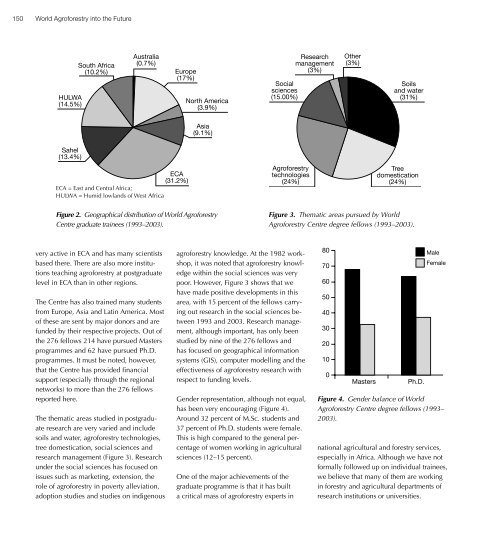The challenge of HIV/AIDS: Where does agroforestry fit in? - World ...
The challenge of HIV/AIDS: Where does agroforestry fit in? - World ...
The challenge of HIV/AIDS: Where does agroforestry fit in? - World ...
You also want an ePaper? Increase the reach of your titles
YUMPU automatically turns print PDFs into web optimized ePapers that Google loves.
150<strong>World</strong> Agr<strong>of</strong>orestry <strong>in</strong>to the FutureHULWA(14.5%)South Africa(10.2%)Australia(0.7%)Europe(17%)North America(3.9%)Socialsciences(15.00%)Researchmanagement(3%)Other(3%)Soilsand water(31%)Asia(9.1%)Sahel(13.4%)ECA(31.2%)ECA = East and Central Africa;HULWA = Humid lowlands <strong>of</strong> West AfricaAgr<strong>of</strong>orestrytechnologies(24%)Treedomestication(24%)Figure 2. Geographical distribution <strong>of</strong> <strong>World</strong> Agr<strong>of</strong>orestryCentre graduate tra<strong>in</strong>ees (1993–2003).Figure 3. <strong>The</strong>matic areas pursued by <strong>World</strong>Agr<strong>of</strong>orestry Centre degree fellows (1993–2003).very active <strong>in</strong> ECA and has many scientistsbased there. <strong>The</strong>re are also more <strong>in</strong>stitutionsteach<strong>in</strong>g agr<strong>of</strong>orestry at postgraduatelevel <strong>in</strong> ECA than <strong>in</strong> other regions.<strong>The</strong> Centre has also tra<strong>in</strong>ed many studentsfrom Europe, Asia and Lat<strong>in</strong> America. Most<strong>of</strong> these are sent by major donors and arefunded by their respective projects. Out <strong>of</strong>the 276 fellows 214 have pursued Mastersprogrammes and 62 have pursued Ph.D.programmes. It must be noted, however,that the Centre has provided f<strong>in</strong>ancialsupport (especially through the regionalnetworks) to more than the 276 fellowsreported here.<strong>The</strong> thematic areas studied <strong>in</strong> postgraduateresearch are very varied and <strong>in</strong>cludesoils and water, agr<strong>of</strong>orestry technologies,tree domestication, social sciences andresearch management (Figure 3). Researchunder the social sciences has focused onissues such as market<strong>in</strong>g, extension, therole <strong>of</strong> agr<strong>of</strong>orestry <strong>in</strong> poverty alleviation,adoption studies and studies on <strong>in</strong>digenousagr<strong>of</strong>orestry knowledge. At the 1982 workshop,it was noted that agr<strong>of</strong>orestry knowledgewith<strong>in</strong> the social sciences was verypoor. However, Figure 3 shows that wehave made positive developments <strong>in</strong> thisarea, with 15 percent <strong>of</strong> the fellows carry<strong>in</strong>gout research <strong>in</strong> the social sciences between1993 and 2003. Research management,although important, has only beenstudied by n<strong>in</strong>e <strong>of</strong> the 276 fellows andhas focused on geographical <strong>in</strong>formationsystems (GIS), computer modell<strong>in</strong>g and theeffectiveness <strong>of</strong> agr<strong>of</strong>orestry research withrespect to fund<strong>in</strong>g levels.Gender representation, although not equal,has been very encourag<strong>in</strong>g (Figure 4).Around 32 percent <strong>of</strong> M.Sc. students and37 percent <strong>of</strong> Ph.D. students were female.This is high compared to the general percentage<strong>of</strong> women work<strong>in</strong>g <strong>in</strong> agriculturalsciences (12–15 percent).One <strong>of</strong> the major achievements <strong>of</strong> thegraduate programme is that it has builta critical mass <strong>of</strong> agr<strong>of</strong>orestry experts <strong>in</strong>80706050403020100MastersPh.D.MaleFemaleFigure 4. Gender balance <strong>of</strong> <strong>World</strong>Agr<strong>of</strong>orestry Centre degree fellows (1993–2003).national agricultural and forestry services,especially <strong>in</strong> Africa. Although we have notformally followed up on <strong>in</strong>dividual tra<strong>in</strong>ees,we believe that many <strong>of</strong> them are work<strong>in</strong>g<strong>in</strong> forestry and agricultural departments <strong>of</strong>research <strong>in</strong>stitutions or universities.




![MNC_00_Modau [Compatibility Mode].pdf](https://img.yumpu.com/51432208/1/190x146/mnc-00-modau-compatibility-modepdf.jpg?quality=85)











